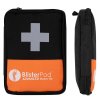Thanks for the tip! Had never heard of it before.
But I doubt that one thing can prevent all kinds of blisters 100%

. Not saying your solution doesn't help, it's always good to have more tools in the box! So, thanks for sharing that!
From my experience it's a bit more complicated, though, with different strategies needed depending on the source of the problem. Soaking feet will not help against blisters one gets from too small shoes, for example.
It really depends on why the blister occurs. There are different kinds of blisters which have different causes, so different things will work or not to prevent them.
So if it is okay for you I'll add some additional strategies to prevent blisters

.
Is the shoe too big? That will cause the foot to slide in the shoe, which causes friction, and usually superficial blisters. You can try a thicker insole or sock. Also tighten the laces more. Vaseline can help to reduce friction, or double socks.
Is the shoe too small or has the wrong fit? That will cause pressure, usually in certain points. Feet of different people have very different shapes and need different shoes. Some manufactures models are more wide, some more narrow, sometimes even a special model is needed, for example for people with hallux valgus. If the shoe is too small you can try thinner insole or socks. If the fit ist wrong you can only change to another shoe. As a on-the-way-fix I have seen people cut holes into their shoes where they had pressure points... Sometimes tying laces differently helps, too (less tight in certain part of the shoe).
Is there too much moisture/sweat? This will cause the skin to get more soft and blisters form more quickly. You can try a different sock fabric, panty liners as liner in the shoes, foot powder... and most important, stop often, take off shoes, let the feet air out and change socks!
Dirt in the shoes. Dust can accumulate, and travel through the fabric of the socks after a while, and will cause friction. Solution: change socks frequently, wash feet from time to time during the day when you see a fuente or river.
Pressure blisters on the sole of the foot. Usually on ball of the foot and heels. Those I find to be the worst. Cause is too much weight (body+backpack), hard surfaces (asphalt walking) and little cushion from the sole of the shoe ("dead" shoes, minimal/barefoot shoes...). Those blisters can be very deep and can take a long time to properly heal. Even with good strong skin, they can form deep *under* that, even in layers (blister under blister). Prevention: lighter backpack, walk on the side of the road in the grass whenever you can, soft insole, more rest stops, shorter walking days, shoes with more cushioned soles. This is the only kind of blister that ever stopped me from walking for a few days.
Socks too small. Will put pressure on the toes and cause blisters on the toes. Use bigger socks.
Socks too big. Fabric will get wrinkles which causes friction, which causes blisters. Change to smaller/tighter socks.
Blisters that form because of an injury - for example problem with left knee or foot, you tend to put more weight on the right leg, will shift your gait, which can cause more injuries and/or blisters. Get the root problem fixed. Use hiking poles.
I probably forgot other kinds of blisters or am oblivious to their existance, but those are the kinds I've had or have seen people with that problem.
A few things that can help to prevent blisters in general:
- walk shorter days
- walk more slowly
- make plenty short stops and at least one longer stop during the day to rest your feet
- take off shoes and socks, air the feet, elevate the feet during those stops (not on the chairs in a bar, please). Taking a nap in the grass and putting feet up on the backpack works well.
- change socks during the day, bring one extra pair for that.
- reduce pack weight
- Drink enough water (important to prevent any kind of injuries in general)
- footcare (you want tough skin but not too thick callouses which can also create problems). Soaking ect. with certain products, water with salt and vinegar, ect. falls under this category for me.
- If you notice a pressure point forming, stop immediately (!), tape it and/or cushion it with hikers wool, ask yourself what could have caused it. Fix the cause if possible (adjust/change socks, elevate/air feet for a while, walk more slowly ect.).
Wishing a blister free Camino to everyone!























